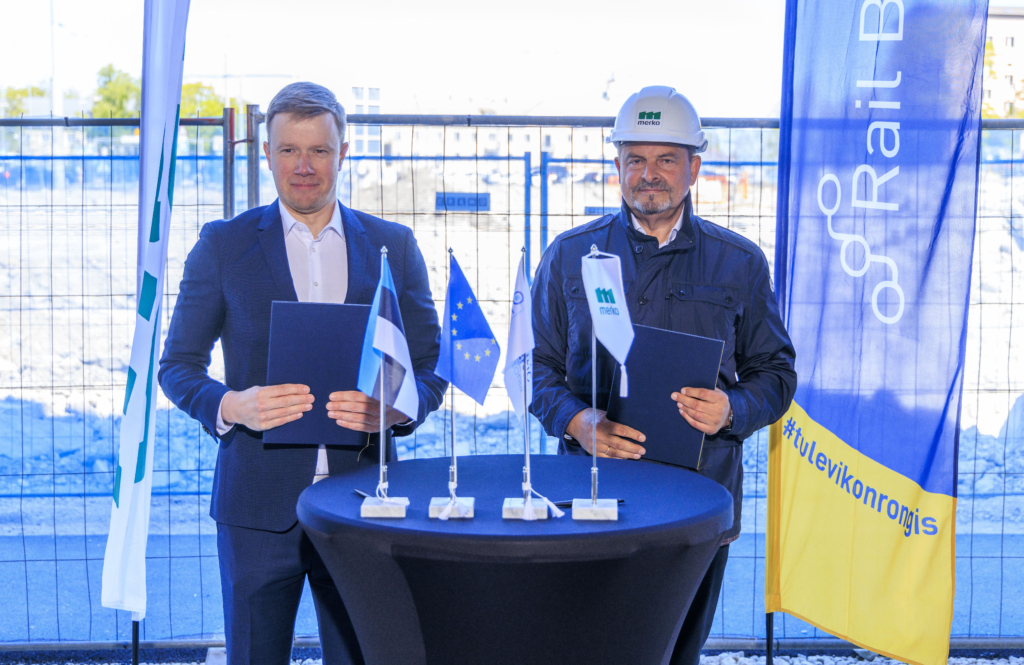Rail Baltica Ülemiste passenger terminal construction to start
Under the terms of a construction contract concluded with Rail Baltic Estonia today, Merko is set to shortly start construction of Rail Baltica’s international passenger terminal. In future, the building, boasting a facade and roof design not seen elsewhere in Estonia, will be the northern gateway to the high-speed railway line leading to European cities.
The Ülemiste terminal will be Rail Baltica’s most distinctive public building and also its symbolic starting point. When the first high-speed train leaves Tallinn for Warsaw in 2030, it will pull out of Linda terminal, named after a character in the Estonian national epic. Ülemiste will be the Baltic region’s most modern public transport junction, with easy and rapid access to the airport, located at the confluence of tram and bus routes, cycle paths and the embarkation point for high-speed trains to Warsaw and beyond.
“Ülemiste Linda terminal is unprecedented in Estonian railway history – not just a building but Estonia’s new gateway to the world,” said Anvar Salomets, thechairman of the management board ofRail Baltic Estonia. “Designed by Zaha Hadid Architects, the terminal marks a new phase in the development of infrastructure in the Baltic states, which Merko is now carrying out.”
“Rail Baltica is a landmark project that will bring central Europe closer to Estonia and create jobs at many companies. Building a large-scale building with world-class architecture right here in Estonia is an extraordinary opportunity. We are participants in laying the terminal’s underground structures and are very proud that we can now build the unique terminal to completion,” said Jaan Mäe, the chairman of the management board of Merko Ehitus Eesti.
The terminal building will be perpendicular to Suur-Sõjamäe Street, the Rail Baltica line and Eesti Raudtee’s (Estonian Railway) eastbound railway infrastructure, rising to a maximum of 20 meters – about six storeys high. The central part of the building is 180 meters long, with pedestrian tunnels and utility networks to run beneath it. Three platforms with a total length of 1250 meters will be built alongside the tracks, half of that distance to be covered by a roof. The terminal will be designed and built in a manner that allows the railway operations to continue throughout the process, which will necessitate extremely precise planning and coordination.
The construction of the terminal’s underground part was launched by Rail Baltic Estonia in April 2023. Since that time, Merko in cooperation with KMG has been building the load-bearing structures underlying the railway, established the concrete parts of the underground level of the terminal with the help of Merko’s concrete specialists, and built other underground utility lines needed for rail infrastructure.
The Rail Baltica Ülemiste passenger terminal building is based on a design by the internationally acclaimed practice Zaha Hadid Architects, which won an international architecture competition in collaboration with Esplan, an Estonian company. The end result will be a building that is sculptural in form, functional in content, and environmentally conscious, combining aesthetics and top-flight infrastructure functionality.
“The design of Ülemiste terminal was created to integrate smoothly with the surrounding environment, offering passengers high-caliber comfort and connectivity. It also takes into account contemporary environmental standards, which will make it a top-class 21st century transport center,” said Gianluca Racana, director of Zaha Hadid Architects.
The value of the contract is close to 85 million euros, plus VAT. Construction of the terminal will start in November 2025 and the handover of the building to the contracting authority is planned to take place in October 2028. The signed construction contract is financed from the EU’s Cohesion Fund and Connecting Europe Facility (CEF).

Chairman of the management board of Rail Baltic Estonia Anvar Salomets (left) and Jaan Mäe (right) with the signed construction contract
Rail Baltica, co-funded by the European Union, will be a modern and environmentally friendly high-speed railway linking the Baltics to the rest of Europe. Passengers will be able to travel from Tallinn to Pärnu in 40 minutes and from Tallinn to Riga in 2 hours and 20 minutes. The same line will also accommodate local stops and regional trains. Rail Baltic Estonia is the entity developing Rail Baltica in Estonia and in future will administer the Estonian part of the railway’s infrastructure.